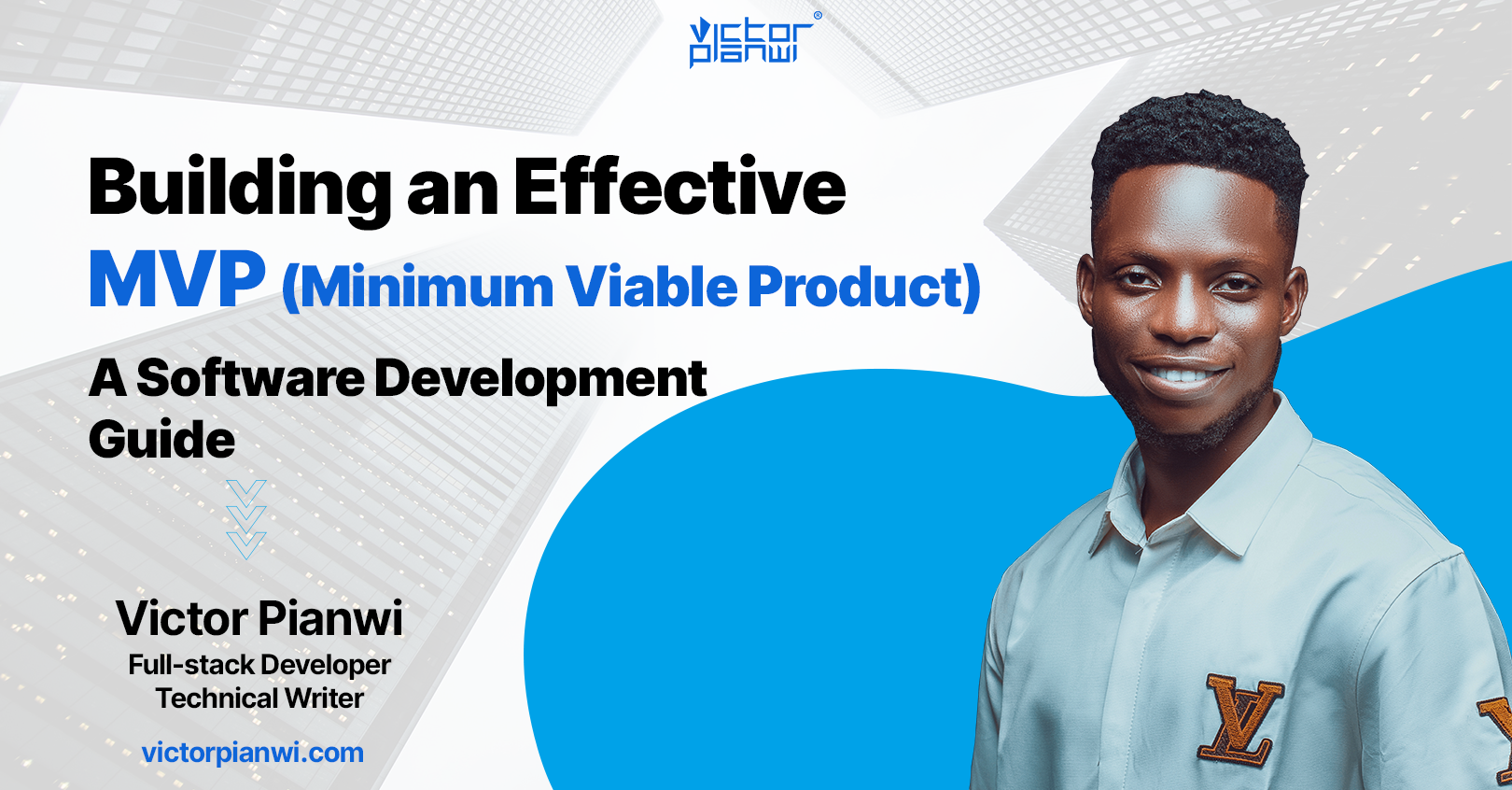Building an Effective MVP: A Software Development Guide
 Victor Pianwi
Victor Pianwi
Creating a Minimum Viable Product (MVP) is a popular and effective method in software development. It helps validate an idea with minimal investment and risk. An MVP is a basic version of a product that includes only its core features. This allows developers and stakeholders to gauge user interest and gather feedback early in the development process. The MVP approach has fueled the growth of major companies like Airbnb, Dropbox, and Twitter. They started with very simple versions of their products and expanded based on user feedback. Let's discuss the concept of an MVP, its benefits, stages of development, and best practices for success.
What is an MVP?
The concept of a Minimum Viable Product was popularized by Eric Ries in his book The Lean Startup. According to Ries, an MVP is a version of a new product that lets a team gather the most customer insights with the least effort. An MVP focuses on the essential features needed to solve a specific problem for early users, allowing development teams to test their ideas without the time and resource demands of a fully-featured product.
In essence, an MVP:
Has minimal features necessary for launch.
Targets early adopters to gather real-world feedback.
Reduces development time and costs.
Helps improve the product through tested learning.
Why Develop an MVP?
Developing an MVP offers several strategic benefits, especially in the competitive and rapidly changing software industry:
Risk Reduction: An MVP reduces the risk of investing too many resources in a product that might not fit the market. By concentrating on core features, companies can avoid expensive errors.
Early Customer Feedback: Releasing an MVP allows companies to engage with real users and understand their challenges. Early feedback is crucial in guiding the product's development.
Cost Efficiency: Developing a fully-featured product can be expensive and time-consuming. With an MVP, companies can save money by focusing on building only the essential features at first.
Market Validation: MVPs are a fast way to test ideas about a product's potential in the market. If the MVP gains interest, it shows a good product-market fit, which can support further investment in development.
Early Revenue: In some cases, an MVP can start generating revenue right away, which can then be reinvested into further development.
Stages of MVP Development
Creating an MVP requires a strategic approach that focuses on understanding the target market, defining core functionalities, and iterating based on user feedback. Here are the key stages of MVP development:
Define the Problem and Audience
A successful MVP starts with a clearly defined problem statement. Identify the challenges your target users face and determine the solution your product will offer. Understanding your target audience is essential, as they will give the feedback needed to enhance your product.
Conduct Market Research
Before developing your MVP, research the competitive landscape to understand existing solutions and how your product can stand out. Market research helps identify unique value propositions and potential challenges, guiding the features of the MVP.
Outline Key Features
Focus on the essential features needed to solve the main problem. Avoid adding "nice-to-have" features that can lead to scope creep. Prioritize functions that are crucial for users to reach their goals, and consider what makes your product stand out from competitors.
Develop and Launch the MVP
With the core features defined, start the development process. Since the MVP should be a simple version of your product, focus on quality rather than quantity. Depending on the project, you can use frameworks and agile methods to speed up the development cycle.
Gather and Analyze Feedback
Once the MVP is launched, collect user feedback through surveys, interviews, and usage analytics. This step is crucial for understanding how well the MVP meets user needs and identifying areas for improvement. Analyzing this feedback will offer insights into which features work well and which need changes.
Iterate and Improve
With user feedback in hand, continuously refine the MVP to improve its usability and performance. This cycle of testing, feedback, and iteration continues until the product is ready for a full release. Based on the feedback, the development team might choose to add new features, optimize existing ones, or even change the product's direction entirely.
Best Practices for Building an MVP
Focus on the Core: Stick to essential features that solve the main problem. Avoid adding extra functionalities that could complicate the MVP and distract from its purpose.
Set Success Metrics: Define clear metrics to evaluate the MVP's success. These could include user engagement, retention rates, or Net Promoter Scores (NPS) to measure customer satisfaction.
Choose the Right Technology Stack: Selecting the right technology stack can make MVP development more efficient. Consider factors like scalability, flexibility, cost, and your team’s expertise.
Prioritize User Experience: While the MVP should be simple, it's important to keep a user-friendly interface. A bad user experience can turn away potential users, affecting feedback and market validation negatively.
Be Ready to Pivot: The feedback you gather might indicate that your original idea or approach needs changes. Being open to making these adjustments is crucial for creating a product that truly connects with users.
Leverage Agile Methodologies: Agile practices offer flexibility and allow for quick changes based on user feedback. Using sprint cycles, iterative development, and collaborative methods can make MVP development faster and more responsive.
Successful Examples of MVPs
Several well-known companies started as MVPs, showing how effective the MVP approach can be:
Dropbox: Before creating a full product, Dropbox released a simple explainer video showing how the product would work. The video generated a lot of interest, validating the idea and justifying further development.
Airbnb: At first, Airbnb's founders tested their idea by listing an air mattress in their apartment for a design conference. This straightforward MVP approach helped them confirm the demand for short-term rentals, leading to the platform's huge success.
Twitter: Twitter started as a side project with basic features—simply a platform for sharing updates in 140 characters. This MVP helped Twitter build a user base, leading to quick development into a full-featured platform.
Challenges in Building an MVP
While the MVP approach has many benefits, there are also potential challenges to keep in mind:
Balancing Minimalism and Quality: Stripping down features to the essentials can sometimes result in a basic product that doesn't engage users. Finding the right balance between simplicity and a satisfying user experience can be difficult.
Managing User Expectations: Users might not understand what an MVP is and may expect a fully functional product. It's important to communicate clearly to set realistic expectations and gather valuable feedback.
Risk of Scope Creep: MVPs are at risk of scope creep, where stakeholders push to add more features than originally planned. Clear documentation and sticking to core objectives can help reduce this risk.
Conclusion
Building an MVP is a proven method in software development that helps companies validate ideas, gain user insights, and reduce risk early in the product lifecycle. By concentrating on core features and gathering real-world feedback, companies can effectively respond to market needs and prioritize future development. With careful planning and a user-centered approach, an MVP can lay the foundation for a successful product that resonates with users and thrives in a competitive market.
Subscribe to my newsletter
Read articles from Victor Pianwi directly inside your inbox. Subscribe to the newsletter, and don't miss out.
Written by

Victor Pianwi
Victor Pianwi
I am a passionate full-stack developer with two years of hands-on experience crafting and maintaining dynamic and responsive solutions, with expertise in web, app and smart contract development, a technical writer and a community manager focused on empowering the community and individuals. I write well-detailed technical articles on self-growth, development(website, application, decentralized application and smart contract) and blockchain.